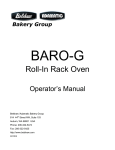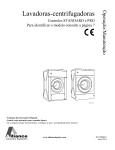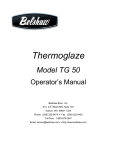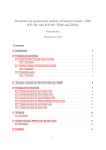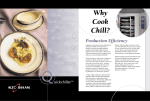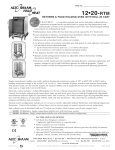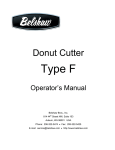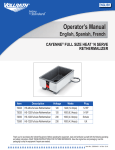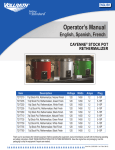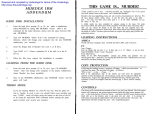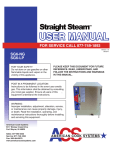Download Victory Freezer Freezer, Reach
Transcript
® Refrigeration at its best. The Victory Guide to Cook-Chill As easy as Refrigeration at its best. Victory Refrigeration – Your First Choice! The Victory Vision “Excellence in refrigerated storage cabinets for the foodservice industry worldwide.” Regarded as a manufacturer of premium refrigeration products for the foodservice industry for over 50 years, Victory Refrigeration maintains a high degree of concern about the integrity of our products. Extensive research and development, superior materials and components, uncompromising quality, and a dedicated work force of skilled craftsmen assure that Victory products exceed the most exacting standards. We are proud to provide top quality products at competitive pricing to the international market with distribution centers throughout the United States, Canada, Mexico, Asia, and the Middle East. A broad and flexible product line, exclusive features, unsurpassed quality, and excellent service make Victory Refrigeration your choice for commercial foodservice refrigeration. Victory Refrigeration is part of the Aga Foodservice Group, a global leader in the foodservice equipment industry which includes companies like Adamatic, Belshaw, Bongard, Williams Refrigeration, and Mono Bakery Equipment. ® 1 PART OF AGA FOODSERVICE GROUP Introduction Advances in technology mean that foodservice establishments of all sizes and types can now benefit from a Cook-Chill System. Victory Refrigeration is leading the way, producing compact, yet sophisticated equipment that suits your needs as well as your budget with easy-to-use controls. Until recently, only large foodservice operations were able to take advantage of a Cook-Chill system, which was often thought to be very complicated because of its size. In fact, the system is quite simple and uses much of the equipment you already have in your kitchen. At Victory, we lead the way in manufacturing and marketing Blast Chillers. From the smallest restaurant to the largest institutional kitchen, Victory provides the innovation and flexibility to respond to your needs. We continually invest in product design and development to bring you the highest quality engineering performance and reliability. Using the latest control systems and technology, Victory’s range of Blast Chillers are all driven by our unique, simple-to-use, “1-2-3 Control Panel” featuring the 3-step operation that all employees will find easy to operate with only basic introduction. With increased focus on food safety, you can be assured that in Victory you have quality, performance, accuracy, and reliability for your product and business. The range of Victory Blast Chillers will help you fully comply with the FDA, state and local requirements, as well as HACCP guidelines. This guide will explore some of the myths that surround a Cook-Chill system, and provide an accurate description of its operation and the benefits it can bring to your business. As you will see in the following pages, a Cook-Chill System can save you time and money, as well as increase productivity and profitability. We hope that you find this guide useful and informative. If you have questions about the terms used in this guide, please refer to the glossary on page 18. If you require additional information, please contact Victory Refrigeration at 800.523.5008. 2 What is Cook-Chill? Cook-Chill is a simple, controlled system of advanced food preparation designed to provide more flexibility in foodservice. The technique involves the full cooking of food, followed by rapid chilling and storage at controlled temperatures, for up to five days. When needed for service, the food must be rethermalized through the use of a Blast Chiller. The production system itself is simple to operate if well managed, and minimizes the risk of food spoilage or contamination. Cook-Chill Systems have the added benefit of retaining food quality, nutritional value, flavor, and appearance. Using a CookChill System also offers the foodservice operator added flexibility and management and, of course, profitability! Who uses Cook-Chill Systems? Thousands of establishments throughout the whole spectrum of the foodservice industry use Cook-Chill Systems. Anyone who has ever eaten at a top restaurant or hotel, at a banquet or reception, or on an airplane or ship is likely to have eaten a Cook-Chill meal. Cook-Chill Systems are also used by many institutional operators such as hospitals and universities. Will my business benefit from Cook-Chill? While Cook-Chill is completely associated with institutional service, no foodservice operation is too small to use a Cook-Chill System. If your business serves hot meals and is one of the following, then you will most certainly benefit: HOTELS • RESTAURANTS • B&Bs• FAST FOOD RESTAURANTS • CATERERS • BAKERIES • MEALS ON WHEELS • AIRLINE KITCHENS • HOSPITALS • UNIVERSITIES • MILITARY KITCHENS • GOVERNMENT • SUPERMARKETS • CORRECTIONAL FACILITIES For large and small establishments, the principles and advantages of the system are the same. The only difference is that small to medium-sized operations do not have to invest in equipment designed to deal with large volume. For the simplest Cook-Chill System, all that is required in addition to the cooking equipment you already have is a Blast Chiller, a suitable storage area such as a refrigerator (at 38°F) and an understanding of the guidelines to Cook-Chill Systems. hotels restaurants fast food restaurants bakeries b&bs airline kitchens meals on wheels caterers military kitchens correctional facilities government hospitals universities supermarkets 3 Why do foodservice operators use Blast Chillers? The principle feature of Blast Chillers is that they are capable of rapidly reducing the temperature of hot foods (+160°F) to low, safe temperatures (+38°F). Therefore, they make it easier for operators to comply with Food Safety regulations. In fact, many caterers are using them solely for that purpose, and in doing so are performing a very simple Cook-Chill operation. Nevertheless, only using a Blast Chiller to cool cooked food rapidly for immediate or same day service, is not making the most of the equipment. Victory Blast Chillers can also be used as shortterm storage cabinets. Avoid the risks of food poisoning – control bacteria growth The very young and elderly are most at risk from food poisoning, however, everyone can be affected. Litigation and prosecution are on the rise, so you can’t afford to take chances. Bacteria can divide in two every 20 minutes and in 12 hours one bacterium multiplies to become almost 69 billion. With a proper Cook-Chill System and Victory Blast Chillers, you can take the risk out of your operation. How quickly will I be able to recover my investment? Your business will be able to immediately recover a portion of your labor costs, reduce waste, maximize efficiency and increase turnover, which accelerate your ability to recover your investment. Potential profit increase up to 28% through higher production capacity, meal turnover and reduced food waste. 4 The Truth Behind Cook-Chill Myth True False The use of Cook-Chill has no limitations. Any meal can be prepared, cooked, chilled, and refrigerated with little or no nutritional or quality loss, and without altering its appearance. There are several misconceptions: Cook-Chill is dangerous because it is difficult to use. There is no known case of someone suffering from or dying as a result of eating a properly prepared Cook-Chill meal. Unfortunately, many people have suffered food poisoning and have died from eating conventionally produced food that has not been prepared or stored properly while using traditional methods. Cook-Chill is only for mass foodservice. No; it can be used by restaurants, clubs and even fast-food operations. The equipment is large and expensive. Small to medium-sized establishments that already have suitable ovens and storage facilities will only need to acquire a suitably-sized undercounter or reach-in Blast Chiller. The equipment required by hospitals and other institutions produce high volumes of food and must accommodate a large capacity. It is an insult to the skill of the foodservice professional. Cook-Chill gives you more time to use your skills more effectively than any other method. Instead of spending valuable time on mundane tasks, the foodservice professional can use that time to improve presentation, create new dishes and menus, and attend to all the other things that make a successful business. In Fact, Cook-Chill... Is simple to operate Is profitable Reduces food waste Saves time Can help improve your business Makes it easy for you to comply with food safety guidelines 5 Advantages of Cook-Chill Suitable for any foodservice operation The system can be used effectively by establishments of any size or type. Effective time management and control system The system allows operators to better organize their time and that of their staff. For example, prime cooking can take place when the business is quiet, leaving less to do when you have customers to attend to while, at the same time, providing a safe, controlled environment and work system. Effective resource management Labor and equipment can be used more efficiently. Ingredients can be bought in larger quantities, providing economies of scale. You can also prepare meals for several establishments from one kitchen. Menu extension The flexibility of the system allows you to prepare a greater selection of dishes, offering your customers more choices while maintaining or improving quality. In addition, because you are preparing meals in advance, you can afford to take time and make fewer mistakes. No modification of recipes A Cook-Chill System allows you to use all your favorite recipes without alteration. Improvement in service Because most food will be prepared in advance, the operator will have more time to improve presentation and serve customers. 6 Flexibility in service Because most dishes only require simple rethermalization prior to service, operators can serve a wider variety of food all day and can easily cope with the fluctuating numbers of customers throughout the day. Reduced food waste and improved portion control Portions can be made up precisely and only the meals ordered will need to be rethermalized. This means little or no waste. Increased profitability All of the above can make your operation more efficient while offering customers greater choice and better service. You will be able to accommodate a larger number of customers, even on short notice, resulting in increased volume and profitability. Fantastic opportunity for expansion If the meal turnover in your business is limited by the number of meals you are presently able to cook and serve with your existing kitchen, Cook-Chill is a fast way to increase your capacity without necessarily expanding your kitchen or employing extra kitchen staff. Roll-In Blast Chiller 7 The Cook-Chill System What you need If you are already serving hot food, the only additional equipment you will require for a small to medium-sized Cook-Chill operation is a suitable Blast Chiller. You will also need a suitable reach-in or walk-in refrigerator for the storage of the finished product. As with any cooking operation, a Cook-Chill System requires care to ensure that food does not become vulnerable to harmful bacteria. Employees should be given specific training on the Cook-Chill operation, in addition to basic food safety training. It is easiest to view a Cook-Chill System as a series of stages. Each of these stages should be regarded as equally important to guarantee safety and good quality meals. 8 1. Selection of raw materials 2. Storage of raw materials 3. Preparation 4. Cooking 5. Portioning 6. Blast chilling 7. Storage of chilled foods 8. Distribution of chilled foods (If applicable) 9. Rethermalization (Reheating of food) 10. Service (Hot) Food Service Operation - How Does it Work? 9 How it Works 1. A selection of raw materials If raw materials are of poor quality when you buy them, they are not going to improve with cooking. It is vital that you ensure your supplier only provides you with high quality products. If necessary, check their storage, handling and distribution methods. 2. Storage of raw materials Having purchased good quality raw materials, it makes sense to keep them in safe storage and in prime condition before they are needed. This means following basic food safety and HACCP principles for food storage to ensure the raw products are stored at the correct temperature and humidity levels. 3. Preparation At the preparation stage, basic food safety practices and HACCP Guidelines apply. Separate surfaces/areas and separate utensils should be used for the preparation of certain products such as raw fish, meat and poultry to prevent cross-contamination and the spread of bacteria. Ideally, food preparation should take place in an area separate from cooking and portioning— as outlined in the HACCP Guidelines. If raw materials arrive frozen, they should be thoroughly and safely thawed before use. We recommend a controlled thawing cabinet for this purpose. Rapid high temperature thawing can encourage the growth of pathogens and may leave cold spots at the core of the food. For this reason, we do not recommend thawing products with a microwave oven unless it is specifically designed to ensure even thawing. In order to make chilling more efficient after cooking, portions of meat should not weigh more than 10 pounds or measure more than 2 inches in thickness. For dense foods such as meat sauce-based dishes— lasagna, casseroles or stews (or even mashed potatoes)—we recommend no more than 2-inch thickness. 10 4. Cooking Whatever the food product you are cooking and by whatever method, it is essential that the core temperature of the food reaches at least 160°F and is held at this temperature for at least two minutes. This is to ensure that any pathogenic micro-organisms that may be present are destroyed. (Check the accuracy of all thermometers used every three months and recalibrate if necessary.) You should not find it necessary to alter your traditional recipes for a Cook-Chill System. 5. Portioning Once the food is cooked, the chilling process must start as soon as possible. At most, within 30 minutes. This leaves time for hot portioning prior to chilling. However, handling of food should be kept to a minimum. Dishes can be assembled from individual components after chilling. Usually, the ideal containers for chilling food should be no more than 2 inches deep. Note: Some containers are made of materials which can insulate the food, thereby affecting chilling times. Covered containers and vacuum packages can also increase chilling times. If disposable containers are used, it is essential that they have been stored under sanitary conditions. 6. Blast Chilling Whatever the type of Blast Chiller you use, it must be capable of chilling the hot food to 38°F within 90 minutes of placing it in the Blast Chiller to begin chilling. This is not only to ensure safety, but also preserves the appearance, texture, flavor, and nutritional value of food. Your Blast Chiller should be equipped with a food probe or probes with which you can monitor the temperature of the food. Every dish has an ideal cooking method suited to its density or structure. This applies to Blast Chilling, too. It is important to have the options of Hard or Soft Blast Chilling available to ensure that food is not damaged in the process and quality is maintained. Hard Blast Chill - During the 90-minute cycle, the air temperature in the cabinet drops below the freezing point. This is designed for dense, large products that are difficult to chill and have a higher fat content, such as meat-based sauces, cuts of meat, mashed potatoes, or lasagna. The air temperature of the cabinet ensures the product reaches the required 38°F within the 90 minutes without the risk of freezing or damaging the food. Soft Blast Chill - During the 90-minute cycle, the air temperature remains above 32°F. This is ideal for delicate and light products such as fish, rice, vegetables, cream, desserts, cakes, and fried foods. The soft blast chilling cycle gently reduces the product temperature to 38°F in the required 90 minutes without the risk of damaging the delicate product. 11 The speed at which chilling takes place will be affected by the shape, size and density of the food, its moisture content, heat capacity and entry temperature. Placing lids on containers or stacking them on top of one another will increase the chilling time required. However, covering food can protect against contamination, and is therefore sometimes appropriate as long as chilling can still be achieved within the required time limits. 7. Storage of chilled foods Chilled food should be stored in a dedicated refrigerated storage cabinet at a temperature of between 34°F and 38°F, in order to control the growth of micro-organisms. You should use the refrigerated cabinet or walk-in designed for chilled food storage, and use it solely for your Cook-Chill products. 12 Chilled food may be kept under the above conditions for up to five days (including production and rethermalization days). To ensure that products do not exceed this time span (and are therefore not wasted), a system of stock rotation should be employed. One method is to use color-coded labels, a different color for each day with a “use by” date, production date and product description marked on each label. A “First In, First Out” policy should be used. 8. Distribution If you intend to operate a centralized Cook-Chill System and supply food to one or more locations, the food must be transported to the other site while in a chilled state. The use of refrigerated vehicles is recommended. At the very least, pre-chilled, insulated containers can be used for short journeys. If chilled food is being transferred to other sites, it must not only be transported at the correct temperature, but, on arrival, it must also be placed in appropriate refrigerated storage cabinets (38°F) until required. 9. Rethermalization Cooked and chilled foods that are to be eaten cold or at room temperature should be consumed within 30 minutes of removal from storage. If the food is to be rethermalized, this should start no more than 30 minutes after the food is removed from chilled storage. Rethermalization must take place close to the point of consumption. Suitable reheating equipment includes microwaves, forced air and steam convection ovens. Traditional types of hot-air ovens may be used, but take care to ensure that exposed areas of food do not dry out. Commercial microwave ovens may also be used, and we recommend these for the reheating of individual portions or small numbers of meals. Ideally, of course, it is preferable to install dedicated rethermalization equipment. In order to ensure the destruction of any pathogens present, the core temperature of the food must reach at least 160°F, and be held at this temperature for at least 2 minutes. To check that this temperature has been reached, insert a core food probe thermometer into the slowest heating point (usually the center). Any food that has been reheated and allowed to cool should be destroyed immediately. Any reheated meals not consumed must be destroyed and never be reheated or returned to chilled storage. 10. Service Once food has been reheated to the required temperature, it should be consumed as soon as possible, and preferably within 30 minutes of reheating. The temperature of the food should not fall below 140°F. 13 Blast Chiller Times Approximate times taken to chill different foods by various Victory Blast Chillers Model Capacity VBC 35 VBC 75 VBC100 VBC175 VBC 220 VBC 350 35 lbs 75 lbs 100 lbs 175 lbs 220 lbs 350 lbs Containers Number Shelves 5 12 VBC 480 VBC 660 480 lbs 660 lbs Roll-in cart 12 1 cart 2 carts MEAT Hard Blast Chill 40–90 minutes depending on type, size and quantity (Includes beef, pork, lamb, poultry pieces, and stock) FISH Soft Blast Chill 30–90 minutes depending on type, size and quantity (Includes fish, e.g. haddock, cod fillets, salmon, and shellfish—fried, poached or baked) PREPARED DISHES Hard Blast Chill 50–90 minutes depending on type, size and quantity (Includes meat-based stews, casseroles, lasagna, mashed potatoes, and risotto) VEGETABLES Soft Blast Chill 30–90 minutes depending on type, size and quantity (Includes carrots, all green vegetables, cauliflower, rice, and sliced potatoes—steamed or roasted) FRUIT Soft Blast Chill 60–90 minutes depending on type, size and quantity (Includes stewed apples, peaches, cherries, rhubarb, and other cooked fruits) DESSERTS Soft Blast Chill 30–90 minutes depending on type, size and quantity (Includes fruit and cream-based desserts, egg custards, flans, and pies) Hard Blast Chill 30–90 minutes depending on type, size and quantity (Includes steam puddings, sponge cakes and dense desserts such as tiramisu and cheesecake) VACUUM-PACKED SOUPS/SAUCES (max 8.5 lbs.) Hard Blast Chill 75+ minutes depending on type, size, quantity, and packaging (Includes all types of soup, custard and sauces) NB: The type of packaging will affect the Blast Chilling time and in extreme circumstances may take longer than 90 minutes. BAKERY PRODUCTS Cakes Cream Cakes Pastry Hard Blast Chill 30–90 minutes depending on type, size and quantity Soft Blast Chill 50–90 minutes depending on type, size and quantity Hard Blast Chill 60–90 minutes depending on type, size and quantity (Includes pies, flans) Please note that the times given in the above chart are approximate and will differ depending on type of product, size, quantity, and containers used. If the products are mixed within the Blast Chiller then cycle times will vary for different products. 14 Choosing the Right Blast Chiller To find out which model of Blast Chiller is the most suitable for your operation, consider the type of food you will be blast chilling, as well as the volume of food you need to produce, calculated in quantity of pounds. When calculating volumes, remember that you may be producing meals for consumption over seven days but with production in only five days. It is also wise to allow a little extra capacity than you require at the present time, in order to allow for the expansion of your business and changing menus. Storage equipment The storage equipment used for holding pre-cooked chilled foods must be designed and used specifically for that purpose. Victory cabinets are equipped with shelves or pan slides. An ordinary commercial refrigerator that is in general use within the kitchen is not usually suitable. Steps must be taken to ensure that possible cross-contamination between raw foods or other cooked products and stored chilled food does not occur. The storage unit must be capable of holding products at a constant temperature of between 34°F and 38°F which should be indicated clearly by a visible temperature indicator. The equipment should also ideally feature an audible alarm that will alert you if the storage temperature reaches unacceptable levels. When selecting storage equipment, allow for sufficient capacity to cope with peak production, as well as room for an efficient stock rotation system. A minimum storage capacity of two days is normal for CookChill products. Storage equipment will need to be located in an area that allows for easy access, and must be sufficiently close to the Blast Chiller to ensure that food arrives at the cabinet without risking any fluctuations in the 34°/38°F chilled temperature—while still at the optimum chill temperature. IMPORTANT! Make sure your cooking, chilling and storage equipment are all compatible with the containers you use. 15 A Practical Example Before Monday Tuesday Wednesday Thursday Friday Saturday Sunday Store Cook Serve Balance 0 0 0 0 0 100 100 0 0 100 100 0 0 100 100 0 0 100 100 0 0 100 100 0 0 100 100 0 Number of meals over the week—600 In this example, the owner of a business in a vacation resort, serving 600 meals per week over six days (50 covers, two sittings and a turnover of one per sitting), realized that there was potential to operate at the same daily turnover on a seven-day basis. However, the reputation of the business was due, in large part, to the quality of the staff that were given Mondays off in lieu of weekends. The option of employing extra part-time staff for Mondays only would wipe out the advantage gained. In any case, skilled staff were almost impossible to find. Meanwhile, potential customers were being turned away to the advantage of other establishments. There had to be another solution. The restauranteur calculated that, by installing a Blast Chiller capable of chilling 175 meals per day, he could reward his staff by giving them weekends off, prime cook only four days a week starting at 8:00 am and increase his meal turnover by 100 meals a week, without incurring any additional staff or premise costs. A production schedule (below) was drawn up based upon a turnover of 100 meals per day, cooking on four days. The unit he selected was the VBC-75. The unit is actually capable of chilling 240 x 20-oz portions per day based on four 90-minute cycles of 75 lbs per cycle. Of course, a greater number could be achieved if the unit were used more times per day. After Monday Tuesday Wednesday Thursday Friday Saturday Sunday Store Cook Serve Balance 16 0 175 100 75 75 175 100 150 150 0 100 50 50 175 100 125 125 175 100 200 200 0 100 100 100 0 100 0 The unit chosen has plenty of spare capacity to cope with the future expansion of the business, which may include extending the present restaurant or setting up an outside banquet service to supply hotels and weddings in the area. In addition, a chilled food cabinet was purchased solely for the storage of the blast chilled food. As a result of installing the Blast Chiller, the restauranteur in question was able to achieve over a 28% increase in gross profit as illustrated by the following figures: Before After Sales Staff Wages Raw Materials Other Expenses $750,000 $90,000 $202,500 $85,500 $875,500 $85,000 $236,250 $93,000 Gross Profit $230,220 $294,720 +28% *Average price of meal is $25. As a result of installing the Blast Chiller the restauranteur in question was able to achieve over 28% increase in gross profit. 17 Glossary Blast Chiller A mechanical unit designed to chill hot food rapidly—from 160°F to 38°F within 90 minutes. It works by re-circulating low temperature air at a high velocity. Hard Blast Chill—160°F to 38°F in 90 minutes Blast Chill cycle suitable for denser items with a higher fat content such as cuts of meat, meat-based sauces, soups, sponge cakes, mashed potatoes, and vacuum-packed products. The air temperature of the cabinet drops below the freezing point during the 90-minute cycle. Soft Blast Chill—160°F to 38°F in 90 minutes Blast Chill cycle suitable for delicate and light products such as fish, rice, vegetables, cream, desserts, and fried foods. During the 90-minute cycle, the air temperature of the cabinet remains about 32°F. Chill Chain The whole process of maintaining strict temperature control throughout the receiving, storage, preparation, processing, storage and distribution of food to control the growth of micro-organisms. Food Core The temperature within an item of food or dish. Temperature taken at the slowest cooking point— normally the center. Pathogenic Micro-Organisms All foods contain a certain level of organisms or bacteria that can carry disease if allowed to multiply to large numbers. Cooking food kills them, while keeping the food below certain temperatures limits their growth. Consequently, a Cook-Chill System is a good way of maintaining food safety as it controls bacteria growth. Probe A thermometer that is inserted into a food product to record the inner temperature. The needle probe should be disinfected after each use. Regeneration The technical term for returning the pre-cooked chilled food back to the safe temperature of 160°F, ready for immediate serving. 18 Equipment Equipment for rapid chilling There are two common methods of rapid chilling: • Using an electro mechanical Blast Chiller, which circulates low temperature air at high velocity. • The immersion of packed products in a suitable refrigerated liquid. The first of these options is the most suitable and convenient for foodservice operators. There are two common types: Large Modular Roll-in Models These are suitable for high volume operations such as hospitals, airline kitchens, schools and correctional facilities. These are designed to move one or more racks of food at a time. Reach-in and Undercounter Models These process smaller amounts and are more suited to restaurants, hotels, employee cafeterias, or where space is limited. Features to look for: Whatever Blast Chiller you choose, it must be capable of reducing the temperature of a 2 inch layer of food from 160°F to between 32°F and 38°F within 90 minutes, when fully loaded. It must also feature an accurate (+/-0.5°F) temperature display, with a built-in food probe featuring digital display. Digital and audible timers are also useful features. Upon completion of the blast chill cycle, the unit should automatically revert to storage mode (32°F/38°F) until the chilling mode is selected again. This enables the operator to put one load in last thing at night, for example, and remove the chilled product first thing in the morning. Victory Blast Chillers offer the ability to audit temperatures at the end of the process via a printer for easy HACCP record-keeping. When selecting a Blast Chiller, be sure that its capacity is sufficient to match maximum production so that blast chilling can commence within 30 minutes after cooking. For the same reason, the Blast Chiller must be located close enough to the cooking area to allow for this time limit to be met. Make sure that the model you choose is compatible with your electrical supply. The best equipment is made from stainless steel. You should also look for a good seal around the door. Poor seals mean an inefficient unit that will cost you money in increased power consumption. Plus, they are less able to comply with the important times referred to in the Cook-Chill Guidelines. Pay close attention to the design. It should be possible to have easy access to the evaporator compartment for cleaning and servicing. Look for removable shelf supports and racking. Cabinets with these features are easier to clean. Automatic defrost and condensate disposal are essential features to look for when selecting a unit. 19 Why Buy Victory Refrigeration? ® Victory Refrigeration has over 25 years experience in designing and manufacturing Blast Chillers. During this time, we have built a worldwide reputation for outstanding quality and performance of our Blast Chiller equipment and the leading technology used in the control panel to ensure ease of use and accuracy. Key Features and Benefits of Victory Blast Chillers • Sleek looks with excellent functional hygienic design, including Victory’s unique, easy-to-use control panel and digital display—simple for all staff to understand, use and control the Blast Chill cycles—designed for accuracy, flexibility and control. • All models fitted with high quality “L” shaped food core temperature probes designed for easy use. Operating the Blast Chill cycle using the food probe ensures perfect temperature control every time and removes any uncertainties from the Blast Chilling process. • Audible alarm sounds at the end of Blast Chill cycle to notify staff—hi/low and fail safe alarms will also sound to indicate if product temperature is too high or too low or the cabinet is not functioning. • Extensive range of models to suit all types of foodservice requirements and environments. Most models are designed for 110°F ambient environments. • Advanced air flow design for uniform chilling of product load eliminates the risk of dehydration and damage by large ice crystals and ensures excellent product quality every time. • All models feature stainless steel exterior and interior with easy-to-clean, sanitary interiors including removable racking/shelving on reach-in cabinets. • Auto defrost on completion of every cycle and every six hours to ensure continued operational efficiency. • Coated evaporator and coils for enhanced life and food safety compliance. • All models automatically switch to storage mode at the end of each Blast Chill cycle for holding product at the right temperature until you are ready to move it to the correct storage cabinet or walk-in refrigerator. • As with all of Victory’s equipment, Blast Chillers are 100% CFC free and manufactured to meet or exceed FDA and HACCP guidelines. 20 Advanced airflow design of Victory Blast Chillers. Operation: Operating Victory Blast Chillers is as easy as 1-2-3. You can operate the Blast Chill cycles using pre-set chill times or with the food core temperature probes. Control Buttons Press to select Blast Chill or storage. Press to select Hard or Soft Chill. Press to select time options 30, 60, 90 or 240 minutes (depending on the size of load and product). Press ✔ to start the Blast Chill. If you have made a mistake press ✗ and start again. During the Blast Chill cycle the cabinet temperature will be shown throughout the process. Food Probe Control Press to select Blast Chill. Press to select Hard or Soft Chill. Press to select food probe. Ensure the probe or probes are placed in the center of the products being chilled. Press ✔ to start the Blast Chill cycle. When using the food probe during the Blast Chill cycle, the LED display shows the elapsed time and also indicates the product’s core temperature. This feature is unique to the Victory range of Blast Chillers. The first window will show the elapsed time and the second window will show the core food temperature(s). The ten rectangular LEDs will light up to indicate how far through the cycle the Blast Chiller is as a percentage. Once the cycle is complete, the Blast Chiller will go through an auto defrost and automatically switch to storage mode to ensure the food is kept at a safe temperature of 38°F until you are ready to transfer the load to the correct storage cabinet or walk-in. VBC-100 21 A Selection from the Victory Product Line Reach-In Blast Chillers Take control of the Cook-Chill process and eliminate the hazards of slow cooling with this line of stylish, powerful Reach-in Blast Chillers. Designed for small and medium-sized foodservice operations, the Victory line of products combines style, ease-of-use and state-of-the-art technology. • Designed to accommodate sheet pans and hotel pans • Stainless steel exterior and interior • Hard and Soft Chill options • Designed for 110°F ambient environments • Easy as 1-2-3 with the simple control panel or the food core temperature probe • Designed to Blast Chill from 160°F to 38°F in 90 minutes VBC-35 VBC-75 VBC-100 • Capacity 35 lbs • Capacity 75 lbs • Capacity 100 lbs • Five pairs of adjustable pan slides for 12” x 20” x 2 1/2” pans • 12 pairs of adjustable pan slides on 3 1/2” centers for 18” x 26” sheet pans • 12 adjustable white, resin-coated wire shelves • Dimensions: 35” H x 32” D x 28” W • Dimensions: 77 1/2” H x 36” D x 35 1/2” W • Dimensions: 81” H x 40 5/8” D x 43 3/8” W • Optional left-handed door swing and legs • Optional left-handed door swing and legs • Optional left-handed door swing and legs ❄ 22 ❄ ❄ Pictured Left to Right: VBC-75 VBC-35 VBC-100 ® Roll-In Blast Chillers The Victory range of Roll-In Blast Chillers was designed for larger foodservice operations like hospitals, large hotels and airline kitchens. These units feature the standard easy-to-use, 1-2-3 control panel and offer the choice of timed cycles or control using three core food temperature probes. The Roll-In Line accommodates standard roll-in carts and has a stainless steel interior and exterior. Easy access to large area evaporators and high velocity fans promote even chilling, efficient operation, easy cleaning and servicing. There is even the option of a roll-thru design and Victory’s unique “POD” refrigeration system that allows the unit to be used as a 38°F storage refrigerator. VBC-175 VBC-220 VBC-350 ❄ ❄ ❄ • Capacity 175 lbs • Capacity 220 lbs • Capacity 350 lbs • Compartment accepts one roll-in cart 27” W x 40” D x 72” H • Compartment accepts one roll-in cart 27” W x 40” D x 72” H • Compartment accepts one roll-in cart 27” W x 40” D x 72” H • Dimensions: 89”H x 49 3/16” D x 53 1/8” W • Dimensions: 89”H x 49 3/16” D x 53 1/8” W • Dimensions: 89” H x 49 3/16” D x 53 1/8” W • Options: Roll-thru model, POD-style refrigeration system, left-handed door swing, extra wide doors, insulated floor, floor ramps, and indoor/outdoor condensing units • Options: Roll-thru model, POD-style refrigeration system, left-handed door swing, extra wide doors, insulated floor, floor ramps, and indoor/outdoor condensing units • Options: Roll-thru model, POD-style refrigeration system, left-handed door swing, extra wide doors, insulated floor, floor ramps, and indoor/outdoor condensing units VBC-480 VBC-660 • Capacity 480 lbs • Capacity 660 lbs • Accommodates 2 roll-in carts 27” W x 40” D x 72” H • Accommodates 2 roll-in carts 27” W x 40” D x 72” H • Dimensions: 97”H x 92 1/2” D x 53 1/8” W • Dimensions: 97”H x 92 1/2” D x 53 1/8” W • Options: Roll-thru model, POD-style refrigeration system, left-handed door swing, extra wide doors, insulated floor, floor ramps, and indoor/outdoor condensing units • Options: Roll-thru model, POD-style refrigeration system, left-handed door swing, extra wide doors, insulated floor, floor ramps, and indoor/outdoor condensing units ❄ ❄ VBC-220 *For complete information, please refer to the product specification sheets, contact your local authorized Victory dealer, or call 800.523.5008. 23 ® Cook-Chill: Step-by-Step 3 PREPARATION • Raw materials should be prepared in areas separated from cooking and post-cooking areas. 1 RAW MATERIALS • Buy from reputable suppliers. • Products should be held at temperatures below 38°F until cooking commences. • Choose good quality products. 2 • Frozen products should be control thawed before use. STORAGE 4 • Raw materials should be stored at recommended temperature and humidity levels, in accordance with food safety and HACCP guidelines. COOKING • The core temperature of food must reach at least 160°F and should be held at this temperature for at least two minutes. • Check the core temperature using a probe thermometer inserted into the slowest heating point, normally the center. 24 5 BLAST CHILL • The rapid chilling process must begin within 30 minutes of cooking being completed. • Once in the chiller, the food must be chilled to a temperature between 34°F and 38°F within 90 minutes. 8 RETHERMALIZATION • Cooked and chilled foods that are to be eaten cold should be consumed within 30 minutes after removal from storage. • Rethermalization must take place close to the point of consumption. • The core temperature of food must reach at least 160°F and should be held at this temperature for at least two minutes. • Rethermalized food that has cooled below 150°F should be reheated for service. 6 CHILLED STORAGE • Cook-Chill foods should be stored in a cabinet designed for the purpose. • Pre-cooked chilled food should be stored at between 34°F and 38°F for a maximum period of 5 days. • Food should be clearly labeled with a description, product date andexpiration date. • A stock rotation system should be used. 9 SERVICE • Once food has been rethermalized to the required temperature, it should be consumed as soon as possible, preferably within 30 minutes of reheating. • The temperature of the reheated food should not be allowed to drop below 140°F. 7 DISTRIBUTION •Pre-cooked, chilled foods must remain at their chilled state (34°F to 38°F) until they reach the regeneration site. • Any food left after service which has been regenerated must be destroyed. 25 Need More Information The highly trained and experienced Victory Sales and Technical Team will be pleased to advise you on the operation and requirements of Cook-Chill. For more information, please contact 800.523.5008. For more details of the HACCP (Hazard Analysis Critical Control Point) Guidelines, we recommend you visit the FDA website at www.cfsan.fda.gov/~comm/haccpov.html or contact: USDA/FDA Foodborne Illness Education Center National Agricultural Library 10301 Baltimore Boulevard, Room 304 Beltsville, Maryland 20705 301.504.5719 fax 301.504.6409 ® VICTORY REFRIGERATION 110 Woodcrest Road Cherry Hill, New Jersey 08003 800.523.5008 fax: 856.428.7299 www.victory-refrig.com PART OF AGA FOODSERVICE GROUP VGCC 11/02




























